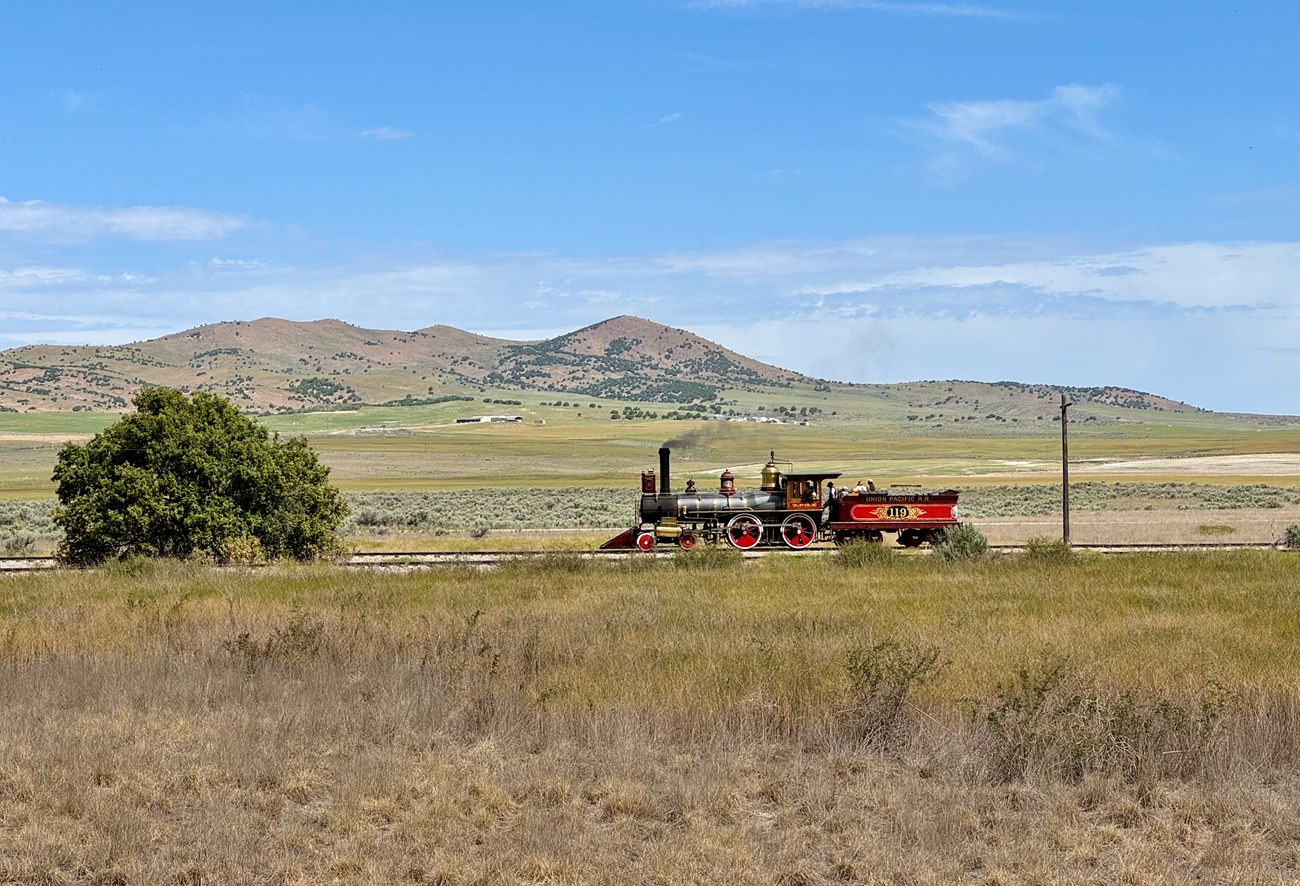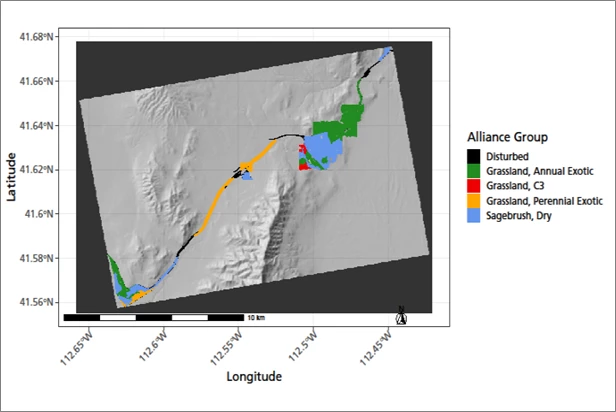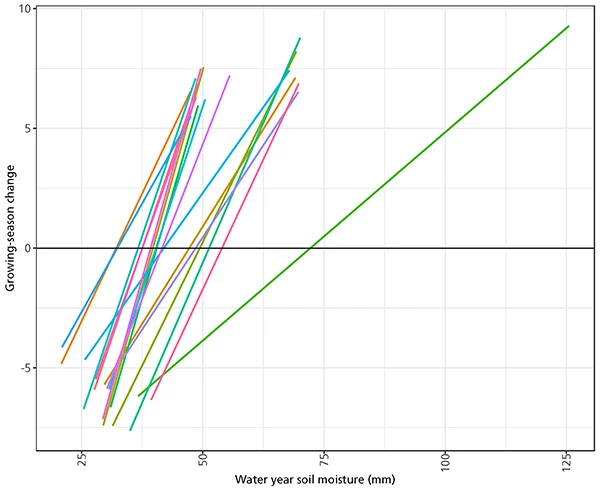Last updated: December 17, 2025
Article
Vegetation Production and Phenology at Golden Spike National Historical Park, 2000–2019

NPS/Amy Washuta
What We Wanted to Know
Scientists with the Northern Colorado Plateau Network (NCPN) analyzed 20 years of satellite imagery and climate data to examine how vegetation at Golden Spike National Historical Park (NHP) responds to weather and climate, with the goal of understanding which vegetation types (also called alliance groups) are most likely to change, where in the park those changes occur, and why, recognizing that not all vegetation responds to climate in the same way. Vegetation response to long-term climate patterns reveals which plant communities are resilient—and which are more likely to shift as the climate changes. The results offer a foundation for anticipating future change and preparing for shifts in vegetation composition and productivity.
What We Did
Researchers analyzed Moderate Resolution Imaging Spectroradiometer (MODIS) satellite imagery (sets of images taken from space to monitor Earth's surface), alongside daily climate data, to evaluate long-term trends in vegetation productivity (how much plant growth occurs over time) and phenology (the timing of growth) from 2000 to 2019. Using polygons mapped to five vegetation types, they assessed how vegetation production and phenology changed over time and how sensitive each group was to different aspects of climate (Figure 1).

NPS/David Thoma
The study calculated pivot points (climate value where plant growth shifts from below average to above average) and responses (change in plant growth rates from one year to the next as weather changed over time). These two measures of plant traits help characterize each vegetation group’s drought tolerance and climate sensitivity. And since climate can be evaluated in different ways, the study tested vegetation response to multiple variables, including precipitation, soil moisture, actual evapotranspiration (water loss through evaporation and plant use), and water deficit.
What We Learned
Although the study began during a dry period, multiple indicators suggest annual trends in growing season vegetation production increased over time for all vegetation types at Golden Spike NHP between 2000 and 2019. The best multivariable indicator of production was three years of soil moisture at the park scale (Figure 2).

NPS/David Thoma
A line graph plots growing-season change (y-axis, –10 to 10) against water-year soil moisture in millimeters (x-axis, 25 to 125). Multiple colored lines represent individual vegetation sites. Lines with steeper slopes indicate vegetation types more sensitive to soil moisture availability. Lines positioned farther left on the x-axis indicate vegetation types with lower drought tolerance. A single green line extends further right, showing a vegetation type that responds more strongly at higher soil moisture levels.
While soil moisture was the best indicator of production, water availability, including precipitation, actual evapotranspiration, and rain, was positively correlated with production. Water deficit and vapor pressure deficit were negatively correlated with production. Perennial Exotic Grassland required less annual precipitation to maintain productivity than other alliance groups. Disturbed areas were least sensitive to annual precipitation, whereas other vegetation types were similar in their response to changes in precipitation.
Phenology metrics revealed notable changes in the timing of growth. By the end of the study across all alliance groups, the growing season was starting 6.2 days earlier and ending 4.5 days later, while the timing of peak growth occurred 15.5 days earlier. Although the growing season started earlier and ended later, the average length of the growing season decreased by 10.6 days, likely due to high variability in determination of start and end of season date that may have been disturbed by land use practices. For example, grazing or weed control may have influenced the landscape phenology detected from remote sensing. The phenology results represent a starting point to understand changes to the landscape, but results should be used with caution.
What We Recommend
Park managers can use the results of this study—and the tools developed from it—to interpret vegetation response in real time, anticipate future conditions, and inform both near-term decisions and long-term conservation goals:
Use pivot points to interpret current conditions: Real-time climate data—such as soil moisture, precipitation, or evapotranspiration—can be compared to vegetation-specific pivot points. This “now-cast” approach allows managers to estimate whether current-year vegetation production is likely to be above or below average (without the complexity of analyzing satellite imagery), helping guide timely decisions during drought or high-heat events.
Monitor high-sensitivity and high-response areas: Annual and Perennial Exotic Grasslands had responses higher than other alliance groups, which means they may be competitive against other vegetation types when precipitation is abundant. Monitoring these areas can help managers anticipate change and prioritize adaptive actions.
Incorporate legacy effects in planning: Because vegetation production often reflects conditions from previous years, restoration planning and invasive-species strategies could factor in multi-year precipitation trends.
Prioritize high-value or sensitive areas: High value vegetation that is important as wildlife habitat, forage, or even visitor enjoyment, such as picnic areas and walking paths, may warrant higher management concern if it is very climate sensitive. Although climate sensitivity varied among alliance groups at Golden Spike NHP, continued monitoring remains important to detect early signs of change in high-value or vulnerable vegetation types due to climate or other disturbance events.
Information in this article was summarized from Landscape phenology, vegetation condition, and relations with climate at Golden Spike National Historical Park, 2000–2019 by D. Thoma (2025). Content was edited and formatted for the web by E. Rendleman.
Tags
- golden spike national historical park
- northern colorado plateau
- northern colorado plateau network
- inventory and monitoring division
- phenology
- phenology monitoring
- vegetation monitoring
- satellite observation
- remote sensing
- long-term monitoring
- disturbed
- annual exotic grassland
- c3 grassland
- perennial exotic grassland
- dry sagebrush
- monitoring
- ncpn
